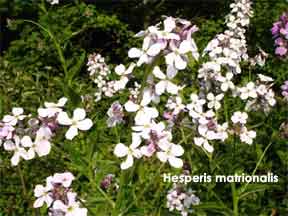Every spring someone is sure to ask me, “How do you make your phlox bloom so early?” Then I have to explain that the graceful plant that brightens a partly shaded corner of my garden is not a phlox, nor even a cousin of that popular perennial, but rather a free-flowering, easily grown perennial which few people seem to have met before – the sweet rocket or dame’s rocket (Hesperis matronalis).
Sweet rocket appeared in my perennial border a few years ago out of nowhere. Since then it has been a constant and welcome guest. It begins blooming in May, lasts in full glory for about a month, and continues to flower casually until September. If the long narrow fruit pods are snipped off as they form, the summer bloom is considerably improved.

Although not quite as showy, the sweet rocket does bear a strong resemblance to the phlox. Its four-petaled flowers (I believe it’s related to the wild mustards) are borne in loose flower-heads. It grows 3 to 41 feet tall and does well in full sun or partial shade. It seeds itself, but not enough to become a nuisance, and it is easily transplanted. I have carried it about the garden in all seasons, and although it may droop for a day if moved out of season it will soon spruce up if well watered.
Rockets do much better than phlox as cut flowers, for their petals do not fade awl drop off so quickly. I have known them to last ten days indoors. Their color is lavender – not as fine as the colors of really good phlox, but far superior to the unattractive magenta of most phlox seedlings. Rockets combine well with many spring flowers, especially daffodils, Alyssum saxatile, bleeding-heart and bush honeysuckle. In summer, when their bloom is more sparse, their rather delicate grace has a softening effect – much like that of baby’s breath, on arrangements of rudbeckia and gaillardia. They have none of the stiffness of phlox.
The rockets in my garden do not seem to attract any pests, and they therefore require no spraying. Their leaves always seem fresh and healthy, and a dark green rosette of them is one of the first signs of life I find after the snows melt.
What I like best about this perennial, however, is its fragrance, delicate always, but most pleasing on a mellow spring evening.


{ 0 comments… add one now }
You must log in to post a comment.